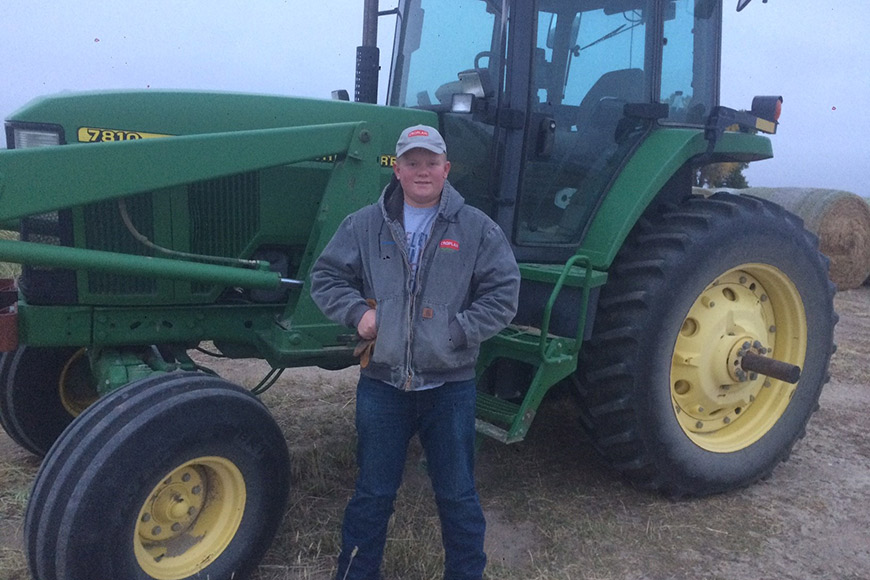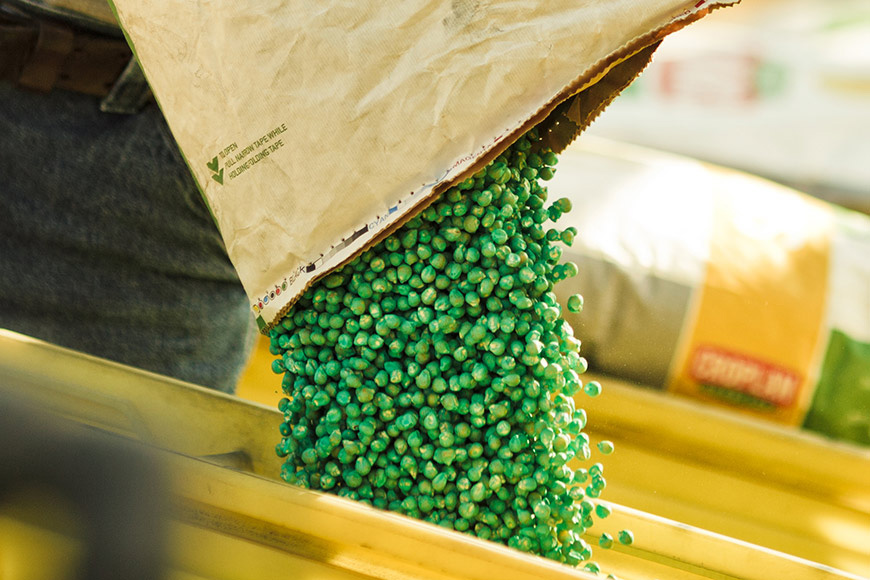6 Ways to Jumpstart Your Sunflower Stand

Once you’ve determined which market to produce for and selected the right CROPLAN® sunflower varieties for your acres, you have to practice the right planting techniques to optimize yield potential. Here are six ways to help start your crop off strong.
1. Get the right seed size
Some farmers have a personal preference when it comes to the size of seed they like to plant, while others are tied to a certain seed size to remain compatible with their planter. Having your CROPLAN sunflower seeds coated with Germains prosun™ precise sunflower seed pellet helps meet those seed size requirements by giving you the ability to select from a variety of consistent seed sizes for most CROPLAN sunflower varieties. Prosun™ precise seed coating offers the following benefits, each of which can contribute to optimizing sunflower yield potential:
Prosun™ precise is not recommended for air seeders, finger planters or plate planters, as those planters can damage the seed coating. The product isn’t available on all varieties, so be sure to consult your locally owned and operated WinField® United retailer when placing your seed order.
2. Supply adequate fertility
Providing sufficient nitrogen (N) is essential to optimizing yield potential, and managing high-yielding sunflower fertility starts with a good soil test. The industry standard for determining how much N to apply is based on your yield goal and the amount of soil test nitrate in the soil at planting. Sunflowers require about 5 lbs N per 100 lbs (cwt) of yield production, so if you’re trying to yield a ton, you should plan on applying 100 lbs N minus soil and other N credits.
It’s difficult to pinpoint how much N sunflower has access to in the soil, however, as soil samples usually only reach down 2 feet. Since active roots are drawing in more N from further down in the soil, it’s common for the crop to outperform yield goals for the N that’s applied.
The North Dakota State University (NDSU) Sunflower Nitrogen Calculator is another popular way to determine how much N to apply. It uses economic and research studies instead of yield goals to recommend the right N rate for your crop.
Sunflowers are a good crop for Variable Rate Technology (VRT), so if your equipment is capable, I recommend working with your agronomist to use a precision ag application to generate field performance potential for every acre. They can identify the best-producing zones, where higher N levels should be placed, and the lower-producing zones, where less N should be applied. As far as timing is concerned, most farmers opt to apply N in the spring to reduce the potential for leaching or denitrification.
3. Plant into clean fields
Whether you’re planting CROPLAN sunflower hybrids with the ExpressSun® trait or the Clearfield® trait, it’s a smart move to start off with a good burndown application. Fall is the best time to get a handle on winter annuals and tough perennial weeds. Since these plants are drawing carbohydrates to their root systems to aid in winter survival, herbicides are carried deeper into the weeds.
A spring burndown application can be an option, but it comes with potential downsides. First, weed root systems can continue to develop over the winter if a fall burndown isn’t performed, allowing them to grow stronger and become more difficult to control in spring. It’s also difficult to reach the roots at this time since plants are pulling carbohydrates out of the root zone to assist with above ground growth. Finally, spring applications can be delayed by wet fields and further hindered if a wide variance in temperatures keeps plant metabolism from kicking in and limits herbicide mobility.
Either way, be prepared to make a pre-emergent herbicide application because sunflowers grow slowly during the first two weeks after planting and is typically seeded at low densities. Thus, early weed competition can take a significant toll on yield potential if not controlled. Fortunately sunflower plants form a dense canopy within about three to four weeks of emergence, so the crop is able to squeeze out weeds that emerge after this time.
Three pre-emergent herbicides that provide good residual control of ALS-resistant weeds and other broadleaf weeds are:
• Spartan® Charge herbicide
• BroadAxe® XC herbicide
• Zidua® SC herbicide
4. Avoid cold soil temperatures
Soil temperature is extremely important when deciding when to seed your sunflowers. Cold soil temperatures can decrease effective germination, so sunflowers should be planted when soil temperatures are at or above 50 degrees F.
5. Seed at the right populations
I typically recommend planting 24,000 to 26,000 seeds/A in heavy soils and 17,000 to 21,000 seeds/A in light soils. But populations should change depending on what marketing product you are seeding:
• NuSun®: 20,000 to 26,000 seeds/A
• Confections: 16,000 to 22,000 seeds/A
• Dehull: 18,000 to 24,000 seeds/A
Sunflowers respond just as well to variable rate seeding as they do variable rate fertility, so this is another good opportunity to employ VRT if your planting equipment allows. Typically this will mean increasing populations in the more productive areas of your fields and decreasing them in zones with lower performance, like hilltops.
6. Plant at the proper speed and depth
Seed to moisture between a depth of 1½ to 2 inches, with 2 inches being optimal. Plant at a speed of 4 to 4.5 mph for consistent seed placement, and follow tillage paths to avoid creating unnecessary roughness in the field.
When it comes to planting, you only get one chance to do it right. So don’t hesitate to reach out to your locally owned and operated WinField United retailer with questions. They can help you put together a customized planting plan for your acres.
© 2020 WinField United. Important: Before use always read and follow label instructions. Crop performance is dependent on several factors many of which are beyond the control of WinField United, including without limitation, soil type, pest pressures, agronomic practices, and weather conditions. Growers are encouraged to consider data from multiple locations, over multiple years, and be mindful of how such agronomic conditions could impact results. CROPLAN®, and WinField® are trademarks of WinField United. NuSun® is a registered trademark of the National Sunflower Association. Spartan® and BroadAxe® are registered trademarks of FMC Corporation. ExpressSun® is a registered trademark of DuPont. Clearfield® and Zidua® are registered trademarks of BASF. Prosun™ is a trademark of Germains Seed Technology.
1. Get the right seed size
Some farmers have a personal preference when it comes to the size of seed they like to plant, while others are tied to a certain seed size to remain compatible with their planter. Having your CROPLAN sunflower seeds coated with Germains prosun™ precise sunflower seed pellet helps meet those seed size requirements by giving you the ability to select from a variety of consistent seed sizes for most CROPLAN sunflower varieties. Prosun™ precise seed coating offers the following benefits, each of which can contribute to optimizing sunflower yield potential:
- Adds weight to seed for improved field placement.
- Reduces dust off and maximizes flowability through planters.
- Provides more uniform stands by reducing skips and multiples.
Prosun™ precise is not recommended for air seeders, finger planters or plate planters, as those planters can damage the seed coating. The product isn’t available on all varieties, so be sure to consult your locally owned and operated WinField® United retailer when placing your seed order.
2. Supply adequate fertility
Providing sufficient nitrogen (N) is essential to optimizing yield potential, and managing high-yielding sunflower fertility starts with a good soil test. The industry standard for determining how much N to apply is based on your yield goal and the amount of soil test nitrate in the soil at planting. Sunflowers require about 5 lbs N per 100 lbs (cwt) of yield production, so if you’re trying to yield a ton, you should plan on applying 100 lbs N minus soil and other N credits.
It’s difficult to pinpoint how much N sunflower has access to in the soil, however, as soil samples usually only reach down 2 feet. Since active roots are drawing in more N from further down in the soil, it’s common for the crop to outperform yield goals for the N that’s applied.
The North Dakota State University (NDSU) Sunflower Nitrogen Calculator is another popular way to determine how much N to apply. It uses economic and research studies instead of yield goals to recommend the right N rate for your crop.
Sunflowers are a good crop for Variable Rate Technology (VRT), so if your equipment is capable, I recommend working with your agronomist to use a precision ag application to generate field performance potential for every acre. They can identify the best-producing zones, where higher N levels should be placed, and the lower-producing zones, where less N should be applied. As far as timing is concerned, most farmers opt to apply N in the spring to reduce the potential for leaching or denitrification.
3. Plant into clean fields
Whether you’re planting CROPLAN sunflower hybrids with the ExpressSun® trait or the Clearfield® trait, it’s a smart move to start off with a good burndown application. Fall is the best time to get a handle on winter annuals and tough perennial weeds. Since these plants are drawing carbohydrates to their root systems to aid in winter survival, herbicides are carried deeper into the weeds.
A spring burndown application can be an option, but it comes with potential downsides. First, weed root systems can continue to develop over the winter if a fall burndown isn’t performed, allowing them to grow stronger and become more difficult to control in spring. It’s also difficult to reach the roots at this time since plants are pulling carbohydrates out of the root zone to assist with above ground growth. Finally, spring applications can be delayed by wet fields and further hindered if a wide variance in temperatures keeps plant metabolism from kicking in and limits herbicide mobility.
Either way, be prepared to make a pre-emergent herbicide application because sunflowers grow slowly during the first two weeks after planting and is typically seeded at low densities. Thus, early weed competition can take a significant toll on yield potential if not controlled. Fortunately sunflower plants form a dense canopy within about three to four weeks of emergence, so the crop is able to squeeze out weeds that emerge after this time.
Three pre-emergent herbicides that provide good residual control of ALS-resistant weeds and other broadleaf weeds are:
• Spartan® Charge herbicide
• BroadAxe® XC herbicide
• Zidua® SC herbicide
4. Avoid cold soil temperatures
Soil temperature is extremely important when deciding when to seed your sunflowers. Cold soil temperatures can decrease effective germination, so sunflowers should be planted when soil temperatures are at or above 50 degrees F.
5. Seed at the right populations
I typically recommend planting 24,000 to 26,000 seeds/A in heavy soils and 17,000 to 21,000 seeds/A in light soils. But populations should change depending on what marketing product you are seeding:
• NuSun®: 20,000 to 26,000 seeds/A
• Confections: 16,000 to 22,000 seeds/A
• Dehull: 18,000 to 24,000 seeds/A
Sunflowers respond just as well to variable rate seeding as they do variable rate fertility, so this is another good opportunity to employ VRT if your planting equipment allows. Typically this will mean increasing populations in the more productive areas of your fields and decreasing them in zones with lower performance, like hilltops.
6. Plant at the proper speed and depth
Seed to moisture between a depth of 1½ to 2 inches, with 2 inches being optimal. Plant at a speed of 4 to 4.5 mph for consistent seed placement, and follow tillage paths to avoid creating unnecessary roughness in the field.
When it comes to planting, you only get one chance to do it right. So don’t hesitate to reach out to your locally owned and operated WinField United retailer with questions. They can help you put together a customized planting plan for your acres.
© 2020 WinField United. Important: Before use always read and follow label instructions. Crop performance is dependent on several factors many of which are beyond the control of WinField United, including without limitation, soil type, pest pressures, agronomic practices, and weather conditions. Growers are encouraged to consider data from multiple locations, over multiple years, and be mindful of how such agronomic conditions could impact results. CROPLAN®, and WinField® are trademarks of WinField United. NuSun® is a registered trademark of the National Sunflower Association. Spartan® and BroadAxe® are registered trademarks of FMC Corporation. ExpressSun® is a registered trademark of DuPont. Clearfield® and Zidua® are registered trademarks of BASF. Prosun™ is a trademark of Germains Seed Technology.





